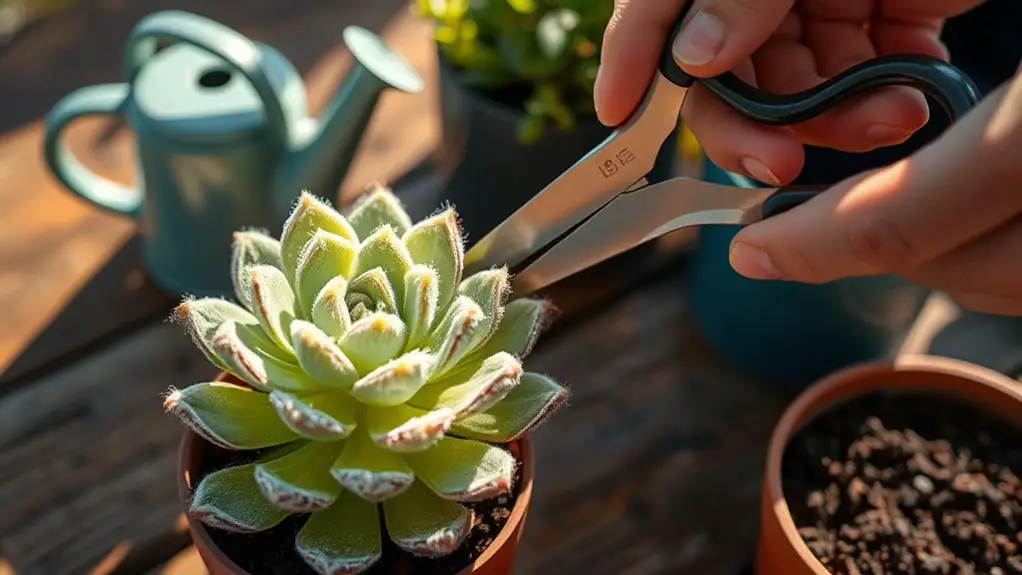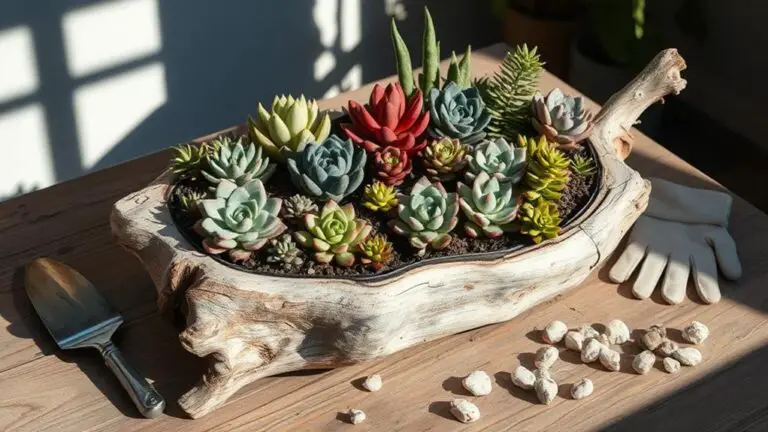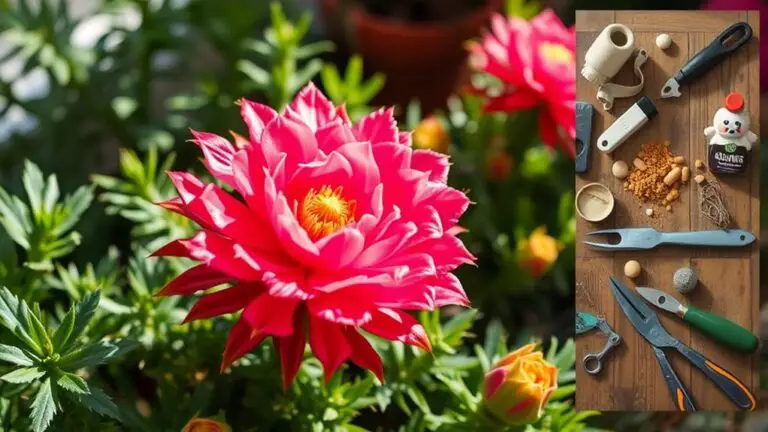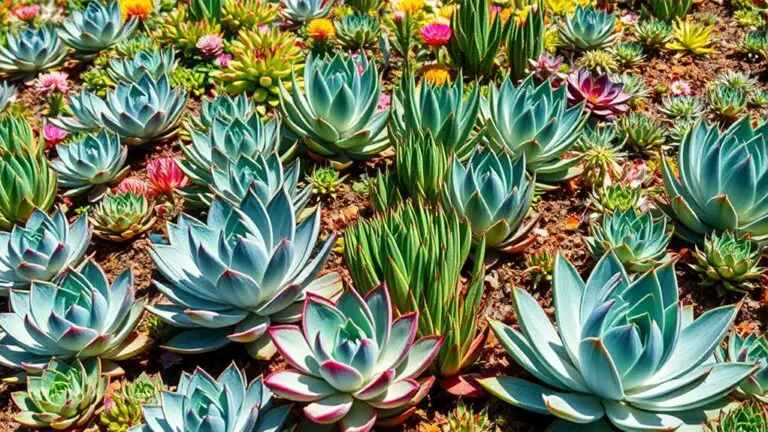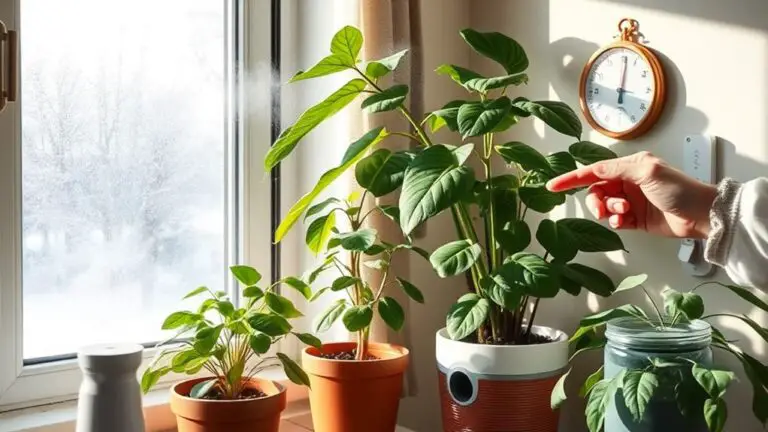Winter Damaged Succulent Treatment – A Step-by-Step Guide
When your succulents suffer winter damage, the first step is evaluating the extent of the harm a few days after the frost or hail. You should prune the severely affected areas while preserving healthy leaves. Gradually reintroduce watering, making sure the soil dries between sessions, and apply mulch to stabilize temperature and retain moisture. You'll want to monitor closely for new growth and distress signals. Avoid overwatering or immediate extensive pruning to aid healing. Interested in knowing how to tackle frost heave or treat desiccation? Let's explore the steps to guarantee your succulents thrive again.
Types of Winter Damage
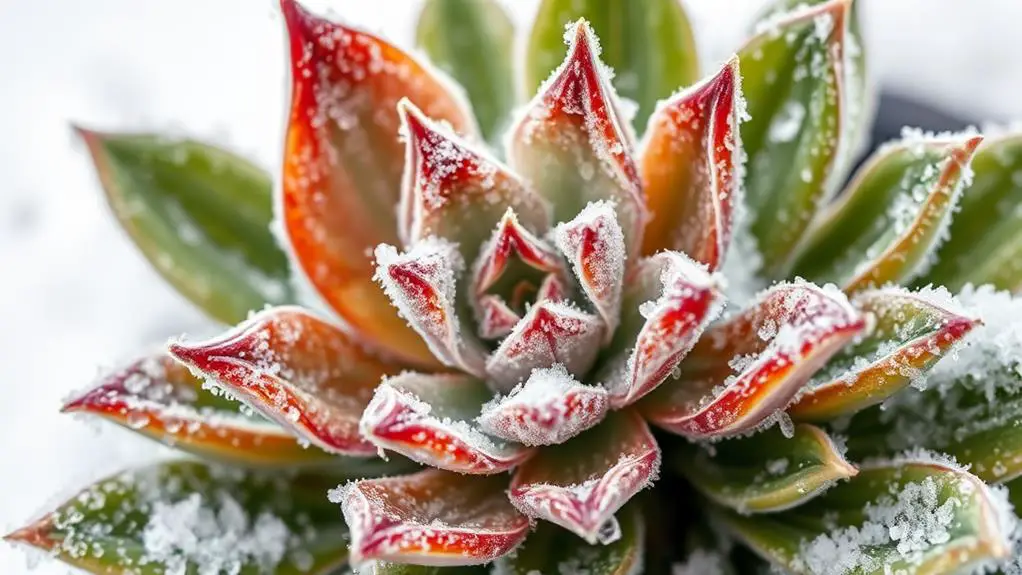
Winter can be tough on your succulents, and understanding the types of damage they might face is essential for effective treatment.
Frost damage is a common issue when temperatures drop below freezing. Ice crystals form inside the succulent's tissues, causing wilting leaves, browning, and a crispy texture.
Desiccation occurs due to dry winter winds, making your succulents lose moisture. This often results in shriveled leaves and overall wilting, especially when the ground is frozen.
Frost heave is another problem. Repeated freeze-thaw cycles push succulents out of the soil, exposing their roots and making them more vulnerable to further damage.
Hail damage can also be troublesome. Hailstones create holes and shredded tips on leaves, which can lead to infections and increased stress.
Branch breakage is another risk, particularly from snow weight, high winds, or careless snow removal. This can result in broken branches or split trunks that need immediate attention.
Recognizing these issues early can help you take the right steps for succulent treatment. By understanding frost damage, desiccation, frost heave, hail damage, and branch breakage, you're better prepared to protect and care for your plants through the cold temperatures.
Frost Damage Treatment
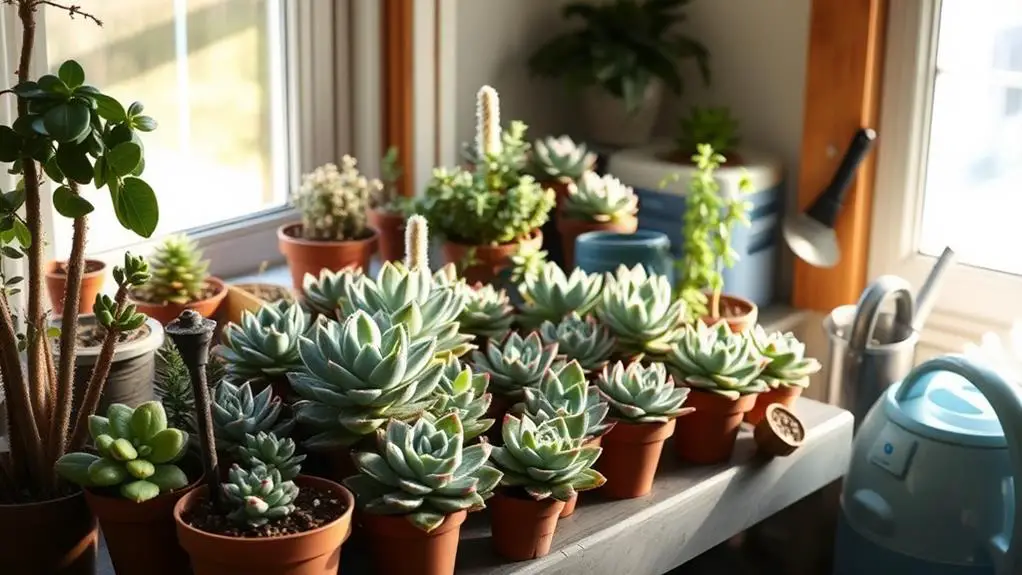
When dealing with frost damage on your succulents, patience is key. Start by waiting for warmer weather or new growth before taking action. This will help your plants avoid further stress and guarantee a healthier recovery.
Next, assess the damage carefully. Prune only the severely affected areas, leaving the healthy leaves intact. These healthy leaves can signal that your succulent still has the potential to bounce back.
After trimming, don't water your succulent right away. Allow the cut areas to dry out and callous over first to prevent shock.
Place your succulents in partial sunlight to aid their healing process. Full, direct sun might be too intense, so a spot with filtered light works best.
Keep a close eye on your plants during this time. Monitoring them for any signs of leaf drop or continued distress is important.
Desiccation Treatment
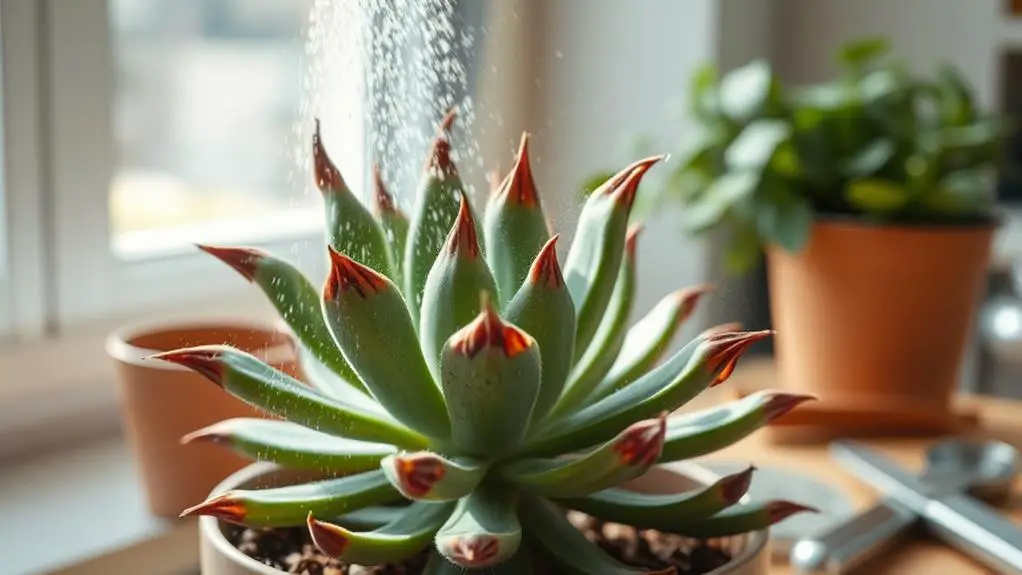
Succulents can suffer from desiccation, a condition where they lose moisture due to dry winds, especially when rooted in frozen ground. This can lead to shriveled leaves and wilting.
To treat desiccation, start by gradually increasing watering. Initially, give a good soak, then let the soil dry out completely between subsequent waterings. This prevents overwatering, which can be just as harmful.
During late autumn and early winter, keep up consistent watering to help your succulents retain moisture and get through the colder months.
Applying mulch around your succulents can make a big difference. Mulch helps reduce moisture loss from the soil and stabilizes temperature fluctuations, protecting the roots from desiccation.
Regularly monitor soil moisture levels, especially when your succulents are in a dormant state during winter. Use your finger or a moisture meter to check the soil. If it feels dry, it might be time for a careful watering.
Frost Heave Solutions
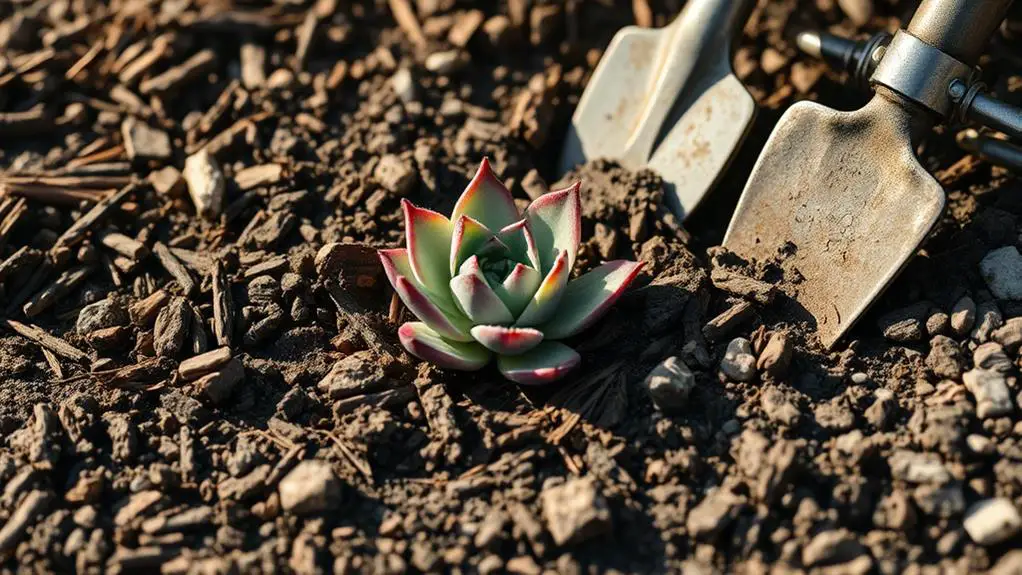
To protect your succulents from frost heave, start by covering any exposed roots with soil right away.
Adding a layer of mulch around the base will also help keep the temperature stable and retain moisture.
Make sure your soil is well-drained to prevent further problems and monitor your plants regularly for best results.
Cover Exposed Roots
Frost heave can wreak havoc on your succulents, pushing their roots above the soil and exposing them to further damage and stress. To protect your plants, you'll need to cover exposed roots as soon as possible.
First, gently place well-draining soil around the roots to shield them from the cold. This not only restores proper soil coverage but also helps prevent root rot. It's important to use soil that drains well, as soggy conditions can be just as harmful as the cold.
Next, consider adding a layer of mulch around your succulent roots. Mulch helps moderate temperature fluctuations and prevents future frost heave by insulating the soil.
During the winter months, regularly check your succulents for signs of frost heave. This way, you can take prompt action and minimize damage.
Use Soil Mulch**
Mulch serves as an essential defense against winter damage for your succulents. Using soil mulch helps protect roots from freezing temperatures and frost heave. Applying a 2-3 inch layer of organic mulch, like straw or wood chips, around your succulents can make a considerable difference. This layer acts as an insulating blanket, keeping the soil temperature more stable during those cold months.
Not only does soil mulch help with temperature control, but it also maintains moisture levels. Mulch reduces desiccation by minimizing evaporation from the soil surface. This guarantees your succulents have enough moisture to stay healthy. Remember, healthy roots mean a healthy plant.
Adding mulch to your winter care routine can greatly enhance your succulents' resilience against winter stressors. Check the mulch regularly for compaction. Over time, mulch can compact, reducing its effectiveness. Replenish it as needed to keep your plants protected.
Incorporating soil mulch into your winter care routine provides multiple benefits. It helps protect roots, maintains moisture levels, and reduces the risk of desiccation. By doing this, you'll promote healthier growth in the spring and keep your succulents thriving year-round.
Hail Damage Recovery

When your succulents face hail damage, start by waiting a few days before evaluating the harm to let the plants stabilize.
Once you're ready, remove any broken stems and leaves to prevent infections and help the plant heal.
Guarantee consistent watering and consider using fertilizers or fungicide sprays to support recovery and encourage new growth.
Assessing Hail Damage
After a hailstorm, it's important to take a methodical approach to evaluate the damage on your succulents. Start by giving your plants a few days to recover. This waiting period allows you to see any natural responses from the plant, making it easier to spot permanent damage.
While evaluating hail damage, look for holes and shredded tips on the leaves. These are common signs that your succulents have been hit hard by the storm.
Next, you'll want to remove broken stems and damaged leaves immediately. Doing this helps prevent further injury and reduces the risk of disease. Be sure to disinfect tools before and after use to avoid spreading any infections.
Consistent watering and using fungicide sprays can be vital in this recovery phase. These steps will help protect the exposed tissues from infection.
Additionally, keep an eye on your plants—monitor plant recovery closely. This will help you gauge how well your treatment strategies are working and make any necessary adjustments.
Removing Damaged Tissue
Dealing with hail damage involves a vital step: removing damaged tissue. Start by evaluating the extent of the damage a few days after the hailstorm. This gives your succulent time to recover from the initial shock.
Once you've identified the broken stems, shredded leaves, or holes caused by hail, it's time to act. Use clean, sharp scissors for pruning. Be certain to sterilize them with alcohol to prevent infection.
Carefully trim away the damaged areas, being cautious to preserve as much healthy tissue as possible. This step is essential for the plant's recovery and guarantees it can continue to photosynthesize efficiently.
After pruning, it's important to allow the cut areas to dry and callous over. This process usually takes a few days. During this time, hold off on watering to prevent rot and help the plant heal.
Once the cuts have dried, you can resume your regular watering schedule. Monitor your plant closely for signs of new growth. This will indicate that the healthy tissue is doing its job and the plant is on its way to recovery.
Promoting Plant Recovery
Giving your succulent the best chance at recovery after hail damage involves a few key steps.
First, wait a few days before evaluating the damage. This waiting period helps you see the full extent of the injury and allows the plant to recover from the initial shock. During this time, some leaves might fall off, which is normal.
Next, carefully remove any broken stems, shredded tips, or severely damaged leaves. Doing this helps prevent infections and reduces stress on the plant. Be gentle and focus only on the most damaged areas to avoid harming healthy parts.
Hydration is essential for recovery. After removing the damaged parts, make sure you water your succulent consistently but avoid overwatering. Too much water can lead to root rot, which you definitely don't want.
Applying a fungicide spray can be a great preventive measure against potential infections from the hail wounds. This step promotes faster healing and keeps your plant healthy.
Keep a close eye on your succulent and monitor it for signs of new growth. New growth is a good indicator that your plant is recovering.
Maintain a stable environment to support its healing process. With patience and care, your succulent will bounce back stronger than ever.
Branch Breakage Repair
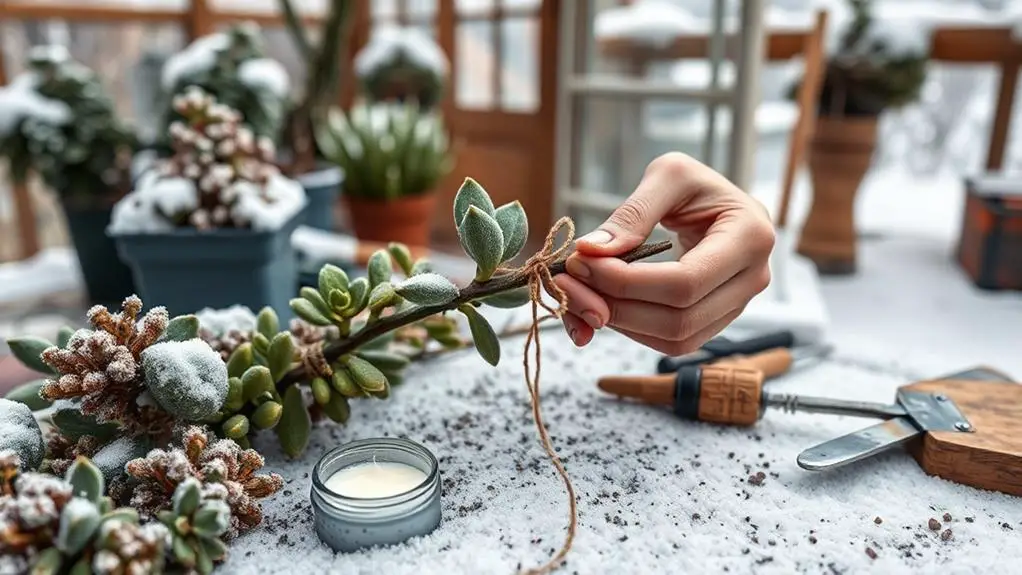
When it comes to repairing branch breakage in your succulents, prompt action is key. Start by pruning all damaged branches immediately. This helps prevent further injury and encourages new growth. Carefully remove any loose or broken branches, making sure your cuts are clean to minimize the risk of infection. Clean cuts are vital for your plant's recovery.
Next, inspect any bent branches for internal cracks. If you find any, cut them off to maintain the overall health and stability of your succulent.
After pruning, it's important to allow the cut areas to callous over before you water the plant. This step prevents rot and supports the healing process.
Once you've taken care of the damaged branches, regularly monitor your plant. Look for signs of new growth, which will indicate that your succulent is successfully recovering from the branch breakage.
This ongoing care is essential for ensuring your plant's health after the winter damage.
Preventative Winter Care
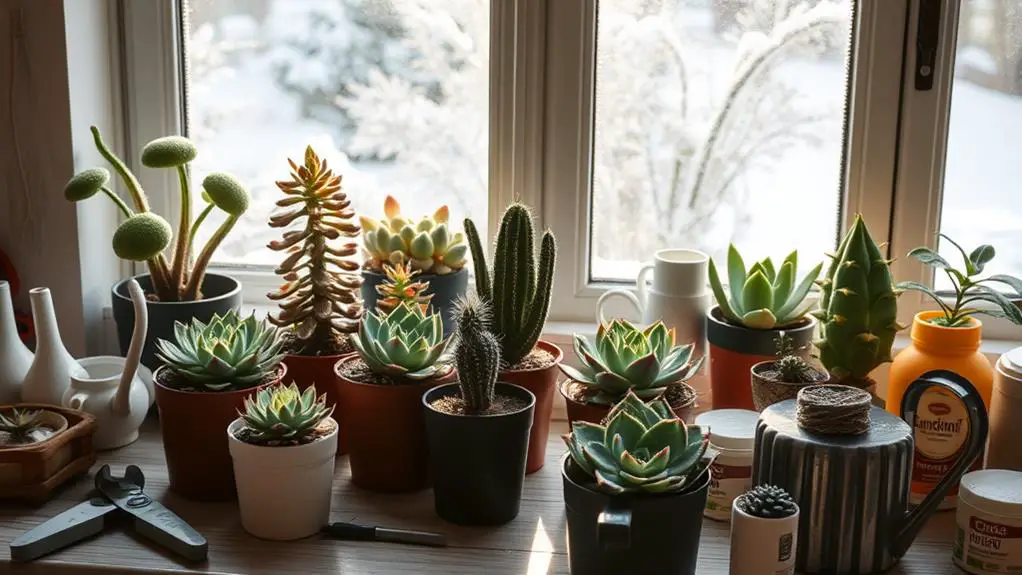
Preparing your succulents for winter is essential to prevent frost damage and guarantee their survival. As the cold weather approaches, it's vital to take steps to protect your plants.
Start by thoroughly watering your succulents before the temperature drops. This helps retain heat around their roots. Avoid pruning in late summer or early fall to protect new growth from being exposed to the cold.
Make sure to monitor temperatures closely. If frost is expected, move potted succulents indoors. For outdoor succulents, using mulch or hay can insulate and shield them from cold winds and ground frost. Additionally, clustering containers together creates a microclimate, offering extra warmth and protection.
To further safeguard your plants, consider these tips:
- Cover vulnerable plants with blankets, frost cloths, or temporary greenhouses.
- Keep an eye on local weather forecasts to plan timely interventions.
- Place indoor succulents in a sunny spot where they can get enough light.
- Create windbreaks using fences or other barriers to reduce exposure to cold winds.
- Avoid overwatering during winter to prevent root rot.
Frequently Asked Questions
How Do You Revive Succulents After Winter?
To revive winter-damaged succulents, move them indoors to a warm spot with indirect sunlight. After two weeks, prune dead parts with sterilized scissors. Let cuts callous before watering sparingly. Monitor health and adjust care accordingly.
What to Do With Frost Damaged Succulents?
Start by evaluating frost damage and wait two weeks before pruning. Move them indoors, trim dead parts with sterilized scissors, and let cuts callous. Re-water carefully, guarantee proper drainage, and gradually reintroduce full sunlight.
How Do You Fix Damaged Succulents?
First, bring your damaged succulents indoors to avoid more frost. After two weeks, trim dead parts with clean scissors. Allow cuts to heal before watering sparingly. Keep an eye on new growth and adjust care as needed.
How Do You Take Care of a Rotting Succulent?
First, remove the succulent from its pot and check for root rot. Trim away any rotted roots, let the healthy roots dry, then repot in well-draining soil. Water sparingly, ensuring the soil is completely dry between waterings.
Conclusion
You've got all the tools you need to help your winter-damaged succulents bounce back. Keep an eye on them, follow the steps carefully, and don't rush the process. Remember, patience and gentle care are key. With time, you'll see new growth and healthier plants. So, roll up your sleeves, and give your succulents the attention they need. You're doing great, and your plants will thank you for it! Happy gardening!

